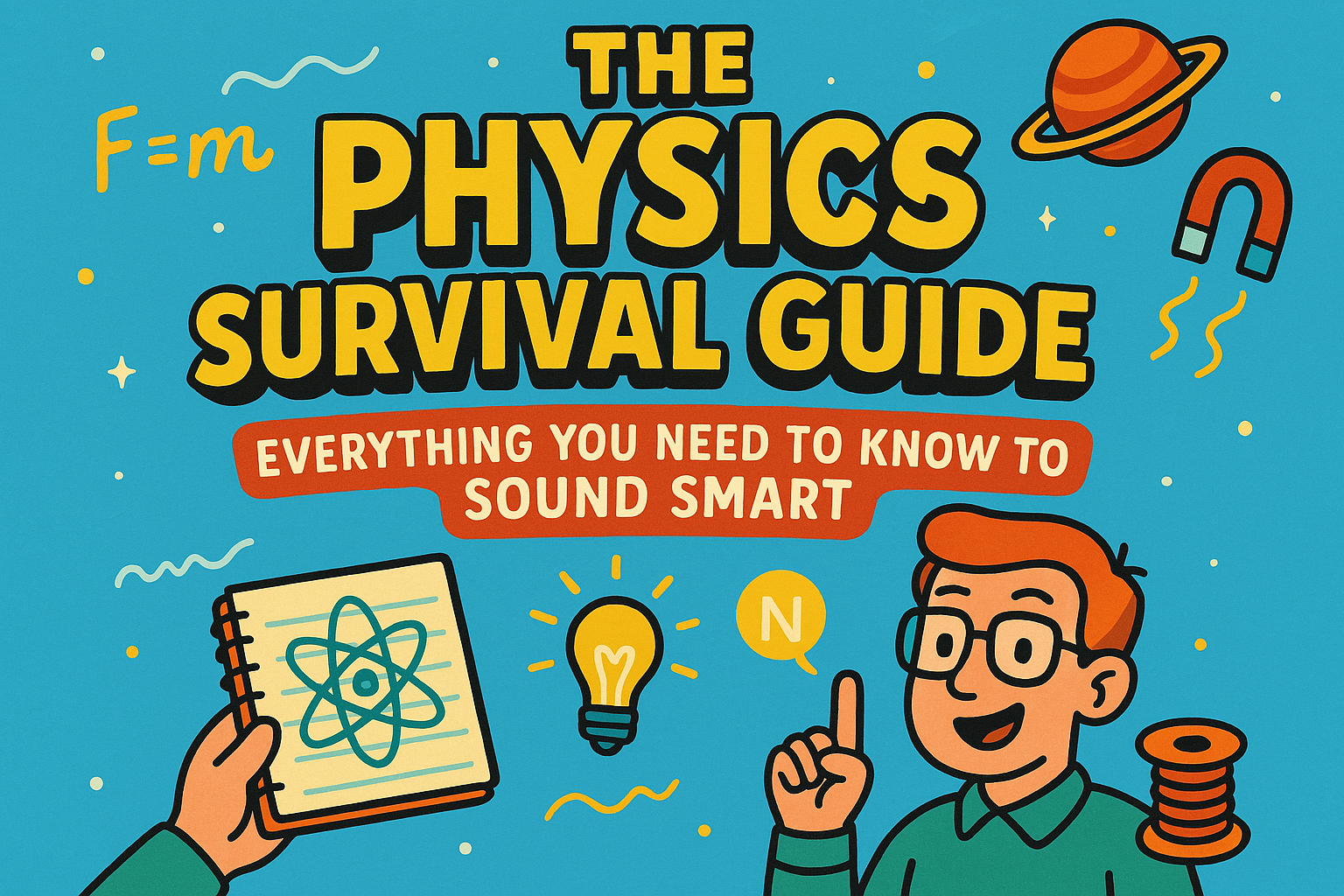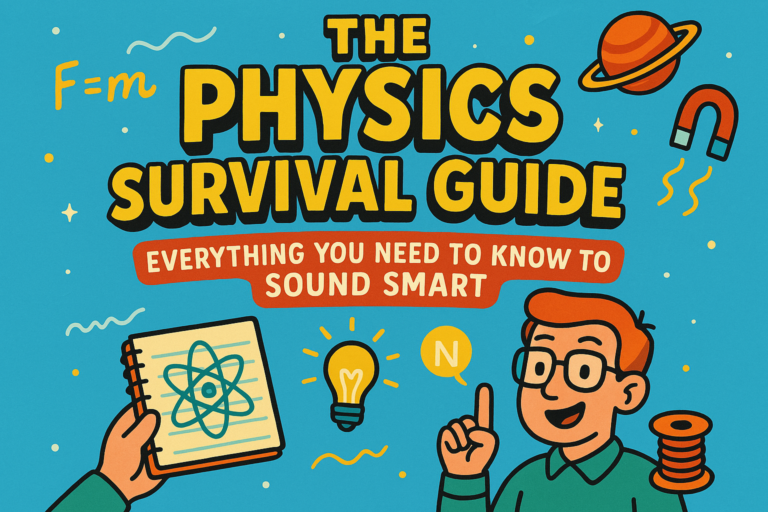The Physics Survival Guide: Basic Physics for Beginners
The Physics Survival Guide: Basic Physics for Beginners
If you’ve ever wondered how things fall, why the sky is blue, or how a light switch works — you’re already thinking like a physicist! This guide on basic physics for beginners is designed to help you understand the key science behind everyday things.
Physics is all about how the universe works, from the tiniest particles to the largest galaxies. You’ll learn about forces, energy, motion, light, sound, and more — all explained clearly with everyday examples.
So let’s jump into the basics and begin your journey into the exciting world of basic physics for beginners.
Basic Physics for Beginners: What Is Physics?
Physics is the science of matter, energy, and how they interact. It’s all about understanding how and why things move, change, and exist. When you kick a football, drop a spoon, or ride a bike — physics is at work.
Scientists love physics because it explains the rules of the universe. Without it, we wouldn’t have electricity, engines, space rockets, or even mobile phones!
If you’re learning basic physics for beginners, this is the perfect place to start. Think of physics as your guidebook to how the world really works — full of exciting discoveries and practical knowledge.
Everything Is Made of Matter
All the stuff you can see and touch — like books, animals, air, and even your body — is made of matter. Matter is made from tiny particles called atoms. These atoms join together to make molecules, which then form everything around you.
Atoms are so small that millions could fit on the tip of a pencil! They are made of three main parts: protons, neutrons, and electrons. These parts help determine how the atom behaves.
Understanding matter is a key step in learning basic physics for beginners. It helps explain why water boils, why ice melts, and even why balloons float!
What Is a Force?
A force is a push or a pull that can make something move, stop, speed up, or slow down. For example, when you pedal a bike, you’re using force. When you stop it using brakes, that’s another kind of force — friction.
Gravity is one of the most important forces. It pulls everything towards the Earth — which is why we don’t float off into space!
In basic physics for beginners, understanding forces helps explain movement, pressure, balance, and why some things are harder to move than others.
How Motion Works
Motion is the change in position of an object. When something moves, it’s in motion. A bus driving down the street, a bird flying, or a ball being thrown are all examples.
Motion follows rules called Newton’s Laws. One important rule is that an object will keep moving (or stay still) unless something forces it to change. That’s why a football eventually stops rolling — friction slows it down.
Basic physics for beginners includes learning these motion rules because they help us design safer cars, build better roller coasters, and even land rockets on the Moon.
Understanding Energy
Energy is the ability to do work — it makes things happen. It comes in many forms: heat, light, movement (kinetic), sound, and even stored energy like in food or batteries.
The cool thing about energy is that it can’t be created or destroyed — only changed. For example, a toaster changes electrical energy into heat energy to make your bread crispy!
Basic physics for beginners teaches how energy works because it’s all around us — powering homes, fuelling our bodies, and making gadgets work.
What Is Light?
Light is a type of energy that travels in waves. It’s the reason we can see! Sunlight, light bulbs, and torches all give off light. Light travels super-fast — faster than anything else in the universe.
Light can bounce (reflect), bend (refract), and split into colours (like a rainbow). You see colours because different objects reflect different parts of the light spectrum.
Learning about light is a fun part of basic physics for beginners. It explains everything from rainbows and shadows to how glasses help people see clearly.
What Is Sound?
Sound is made by vibrations. When something vibrates — like a guitar string or your vocal cords — it creates sound waves that travel through the air. Your ears pick up those waves and your brain turns them into sound!
Loud sounds have bigger vibrations, and high-pitched sounds vibrate faster than low-pitched ones. Sound travels faster through solids than through air, which is why trains can be heard coming through tracks.
Sound is an exciting topic in basic physics for beginners because it links science with music, safety, and communication.
Electricity and Circuits
Electricity is a flow of tiny particles called electrons. It moves through wires in a loop called a circuit. Flip a switch and you complete the loop — turning on a light, fan, or TV.
Circuits can be simple or complex, but they all need a power source (like a battery), wires, and something to use the electricity (like a bulb). Switches let you control the circuit.
Basic physics for beginners includes learning about electricity because it powers nearly everything we use today — from mobiles to microwaves.
Magnets and Magnetism
Magnets are objects that attract certain metals like iron. They have two ends (called poles) — north and south. Opposite poles attract, and like poles push away from each other.
Earth acts like a giant magnet, which is why compasses work — they always point north. You’ll also find magnets in speakers, fridges, and motors.
In basic physics for beginners, learning about magnetism opens the door to understanding how modern machines and technology work.
Machines That Make Life Easier
Machines help us do jobs more easily. Simple machines include levers (like see-saws), pulleys (for lifting), ramps (for rolling things), and screws (to hold things together).
These machines use physics to reduce the effort needed to move or lift something. They’ve been used for thousands of years, from building pyramids to raising flags.
Exploring machines in basic physics for beginners shows how science helps solve real-world problems with clever solutions.
Heat and Temperature
Heat is energy that makes things warmer. Temperature is a measure of how hot or cold something is. We measure it in degrees Celsius in the UK.
When you heat something, the particles inside it move faster. When you cool it down, they slow down. That’s why ice melts when it gets warm — its particles are moving more quickly!
Basic physics for beginners includes temperature because it affects weather, cooking, health, and so much more.
What Do You Remember?
- What is physics and what does it help us understand?
- How do atoms create matter?
- What are three types of energy?
- What does a circuit need to work?
- Why do magnets attract metal?
Write your answers in the comment section below.
Related Topics
If you enjoyed learning about basic physics for beginners, you might want to explore other science topics like chemistry (how substances react), astronomy (space and stars), or engineering (how we use science to build things). Check our Science section in the Info Zone. They all link closely with what you’ve just read.
Also, there is always Wikipedia..
What Do You Think?
If you found this to be an interesting topic, why not have your say. Or if you can think of ways we could improve it. We would love to know what you learned and more importantly, what you think. So now is your chance, use the comments section below to let us know your thoughts.

